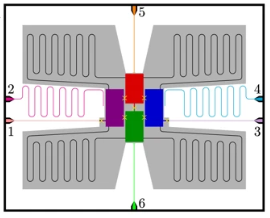AIAS fellows’ collaboration leads to concrete blueprint for a superconducting circuit
A scientific study conducted by current Fellow Nikolaj T. Zinner and Former Fellow David Petrosyan and collaborators in ‘Nature Scientific Reports’ has provided a concrete blueprint for a superconducting circuit that includes a three-level 'artificial atom'. The study outlines how a set of basic calculations can be done considerably faster than if only two levels are available.

Quantum computers hold great promise as future technology. A leading platform for quantum computing is superconducting circuits with both massive academic focus and large industrial investments from companies like Google and IBM.
In its most basic setup, the quantum computer uses the qubit, a two-level system that is an analogy of the classical bit which can be either 0 or 1. However, it has been speculated that if one uses an information storage and calculation system with more than two states, new ways to perform calculation with a quantum system may arise.
In the recent study entitled ‘Realization of efficient quantum gates with a superconducting qubit-qutrit circuit’ published in the journal Nature Scientific Reports, current AIAS Fellow Nikolaj T. Zinner and Former Fellow David Petrosyan from Institute of Electronic Structure and Laser (FORTH), Greece and collaborators have shown how some of this promise may become a reality. By providing a concrete blueprint for a superconducting circuit that includes a three-level 'artificial atom', the paper outlines how a set of basic calculations can be done considerably faster than if only two levels are available.
The application of the three-level 'artificial atom'
The design that the paper outlines may be used to achieve a considerable faster operation for simple tasks in the first generation of quantum computing and information systems. This is enormously helpful since there is still noise in the devices, and fast operation times mean less exposure to this intrinsic noise. With some modifications, the small quantum chips produced so far, by e.g. IBM or Google, may reap the benefits of the new operations that the new paper outlines.
Abstract of the scientific article
Building a quantum computer is a daunting challenge since it requires good control but also good isolation from the environment to minimize decoherence. It is therefore important to realize quantum gates efficiently, using as few operations as possible, to reduce the amount of required control and operation time and thus improve the quantum state coherence. Here we propose a superconducting circuit for implementing a tunable system consisting of a qutrit coupled to two qubits. This system can efficiently accomplish various quantum information tasks, including generation of entanglement of the two qubits and conditional three-qubit quantum gates, such as the Toffoli and Fredkin gates. Furthermore, the system realizes a conditional geometric gate, which may be used for holonomic (non-adiabatic) quantum computing. The efficiency, robustness and universality of the presented circuit makes it a promising candidate to serve as a building block for larger networks capable of performing involved quantum computational tasks.
Full scientific article
T. Bækkegaard, L. B. Kristensen, N. J. S. Loft, C. K. Andersen, D. Petrosyan & N. T. Zinner: ‘Realization of efficient quantum gates with a superconducting qubit-qutrit circuit’’ in: Scientific Reports volume 9, Article number: 13389 (2019): https://www.nature.com/articles/s41598-019-49657-1
Contact
Nikolaj Thomas Zinner, AIAS Deputy Director and Associate Professor at the Dept. of Physics and Astronomy, Aarhus University
zinner@aias.au.dk
Aarhus Institute of Advanced Studies, AIAS
Høegh-Guldbergs Gade 6B
DK-8000 Aarhus C
Denmark
